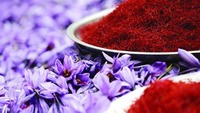Iranian saffron, also known as Persian saffron, is saffron produced in Iran, which is renowned for its exceptional quality and reputation in the global market. Saffron is derived from the stigma of the Crocus sativus flower and is one of the most valuable and sought-after spices in the world.
several distinct features
Iranian saffron is characterized by several distinct features:
1. Color: Iranian saffron typically has a deep red color, which is a sign of high-quality saffron. The intensity of the color indicates the concentration of crocin, the natural pigment responsible for saffron's color.
2. Aroma: Persian saffron has a strong and aromatic fragrance, which is indicative of its freshness and potency. The aroma is often described as floral, honey-like, or slightly bitter.
3. Flavor: Iranian saffron has a complex and distinctive flavor profile, with notes of floral sweetness and a slightly bitter undertone. The flavor intensifies when saffron is infused in liquid or used in cooking, adding depth and richness to dishes.
4. Purity: Iranian saffron is known for its purity and authenticity, as it is cultivated and harvested using traditional methods passed down through generations. The saffron threads are carefully handpicked, sorted, and processed to ensure only the highest quality product reaches the market.
5. Packaging: Iranian saffron is typically packaged in airtight containers to preserve its freshness, flavor, and aroma. The packaging often includes information about the saffron's grade, origin, and certification of quality
Iranian saffron is used in various culinary dishes, including rice, stews, desserts, and beverages, to impart color, flavor, and aroma. It is also valued for its medicinal properties and is used in traditional medicine for its antioxidant, anti-inflammatory, and mood-enhancing effects.
Due to its exceptional quality and reputation, Iranian saffron commands a premium price in the international market and is sought after by chefs, food enthusiasts, and consumers worldwide.

Iran is one of the largest producers and exporters of saffron globally, known for its high-quality saffron threads. The export of saffron from Iran plays a significant role in the country's economy, contributing to its agricultural sector and foreign exchange earnings.
Some key points
Some key points about Iran's saffron export:
1. Production Volume: Iran produces a substantial amount of saffron annually, accounting for a significant portion of the global saffron supply. The main saffron-producing regions in Iran include Khorasan Razavi, South Khorasan, and Kerman provinces.
2. Quality: Iranian saffron is renowned for its exceptional quality, characterized by its vibrant color, strong aroma, and distinct flavor. Saffron produced in Iran is often referred to as Persian saffron and is highly valued in international markets.
3. Export Markets: Iran exports saffron to various countries around the world, including European countries, the United States, the United Arab Emirates, India, and East Asian markets. These exports contribute to Iran's foreign trade balance and generate revenue for the country.
4. Export Regulations: The export of saffron from Iran is subject to regulations and quality control measures to ensure compliance with international standards and the satisfaction of import requirements in destination markets. This includes adherence to packaging standards, certification of quality and authenticity, and compliance with phytosanitary regulations.
5. Promotion and Marketing: To enhance its saffron exports, Iran engages in promotional activities and marketing campaigns to showcase the quality and uniqueness of its saffron products. Participation in international trade fairs, exhibitions, and online marketing efforts are common strategies employed to expand market reach and attract potential buyers.
Overall, Iran's saffron export industry is an important contributor to the country's economy, leveraging its reputation for producing high-quality saffron to access global markets and meet the demand for this prized spice worldwide.

how to export
Exporting saffron involves several steps to ensure successful trade and compliance with international regulations. Here's a general overview of how to export saffron:
1. Market Research: Conduct thorough market research to identify potential export markets for saffron. Consider factors such as demand, competition, regulations, and cultural preferences in target countries.
2. Quality Control: Ensure that the saffron you intend to export meets international quality standards and regulations. This includes testing for purity, potency, and compliance with food safety standards.
3. Obtain Necessary Licenses and Permits: Check the export regulations and requirements of both your country and the destination country. Obtain any necessary licenses, permits, or certifications required for exporting saffron.
4. Packaging and Labeling: Package the saffron in accordance with international packaging standards, ensuring that it is well-sealed and protected from damage during transit. Label the packaging with essential information such as product name, origin, quantity, grade, and expiration date.
5. Documentation: Prepare all required export documentation, including commercial invoices, packing lists, certificates of origin, phytosanitary certificates, and any other relevant documents required by the importing country.
6. Shipping and Logistics: Arrange for the transportation of saffron to the destination country using reliable shipping and logistics services. Choose appropriate transportation methods based on factors such as cost, transit time, and product perishability.
7. Customs Clearance: Ensure that all customs clearance procedures are completed accurately and efficiently. Provide the necessary documentation to customs authorities and comply with import regulations and duties in the destination country.
8. Payment and Financing: Arrange payment terms with your buyers, such as advance payment, letter of credit, or other financing options. Ensure that payment arrangements are secure and mutually agreed upon before shipping the saffron.
9. Marketing and Promotion: Promote your saffron products in target export markets through various marketing channels, such as trade shows, exhibitions, online platforms, and partnerships with distributors or retailers.
10. After-Sales Support: Provide excellent customer service and support to your overseas buyers, including timely delivery, product quality assurance, and resolving any issues or concerns that may arise.
By following these steps and maintaining compliance with export regulations and industry standards, you can successfully export saffron to international markets and build a profitable export business.